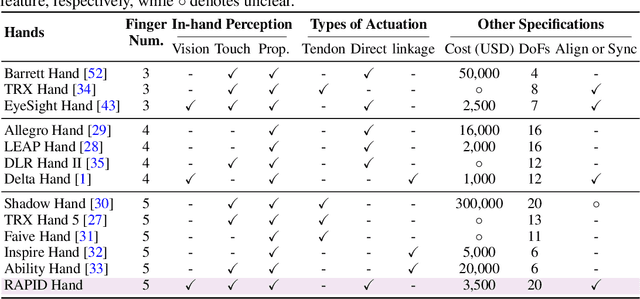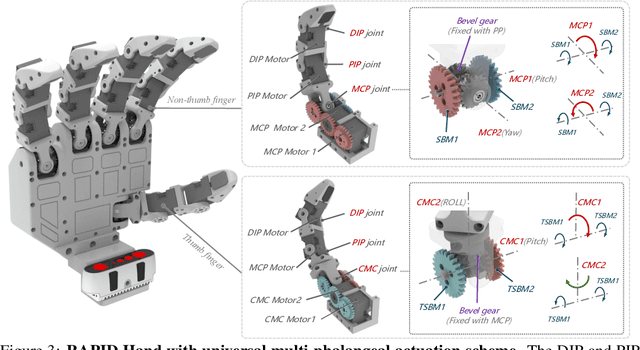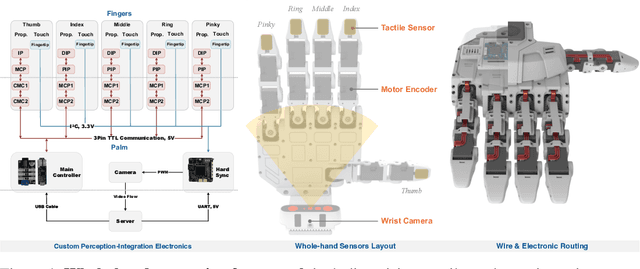Hui Cheng
RAPID Hand: A Robust, Affordable, Perception-Integrated, Dexterous Manipulation Platform for Generalist Robot Autonomy
Jun 09, 2025



Abstract:This paper addresses the scarcity of low-cost but high-dexterity platforms for collecting real-world multi-fingered robot manipulation data towards generalist robot autonomy. To achieve it, we propose the RAPID Hand, a co-optimized hardware and software platform where the compact 20-DoF hand, robust whole-hand perception, and high-DoF teleoperation interface are jointly designed. Specifically, RAPID Hand adopts a compact and practical hand ontology and a hardware-level perception framework that stably integrates wrist-mounted vision, fingertip tactile sensing, and proprioception with sub-7 ms latency and spatial alignment. Collecting high-quality demonstrations on high-DoF hands is challenging, as existing teleoperation methods struggle with precision and stability on complex multi-fingered systems. We address this by co-optimizing hand design, perception integration, and teleoperation interface through a universal actuation scheme, custom perception electronics, and two retargeting constraints. We evaluate the platform's hardware, perception, and teleoperation interface. Training a diffusion policy on collected data shows superior performance over prior works, validating the system's capability for reliable, high-quality data collection. The platform is constructed from low-cost and off-the-shelf components and will be made public to ensure reproducibility and ease of adoption.
GET: Goal-directed Exploration and Targeting for Large-Scale Unknown Environments
May 28, 2025Abstract:Object search in large-scale, unstructured environments remains a fundamental challenge in robotics, particularly in dynamic or expansive settings such as outdoor autonomous exploration. This task requires robust spatial reasoning and the ability to leverage prior experiences. While Large Language Models (LLMs) offer strong semantic capabilities, their application in embodied contexts is limited by a grounding gap in spatial reasoning and insufficient mechanisms for memory integration and decision consistency.To address these challenges, we propose GET (Goal-directed Exploration and Targeting), a framework that enhances object search by combining LLM-based reasoning with experience-guided exploration. At its core is DoUT (Diagram of Unified Thought), a reasoning module that facilitates real-time decision-making through a role-based feedback loop, integrating task-specific criteria and external memory. For repeated tasks, GET maintains a probabilistic task map based on a Gaussian Mixture Model, allowing for continual updates to object-location priors as environments evolve.Experiments conducted in real-world, large-scale environments demonstrate that GET improves search efficiency and robustness across multiple LLMs and task settings, significantly outperforming heuristic and LLM-only baselines. These results suggest that structured LLM integration provides a scalable and generalizable approach to embodied decision-making in complex environments.
Bootstrapping Imitation Learning for Long-horizon Manipulation via Hierarchical Data Collection Space
May 23, 2025Abstract:Imitation learning (IL) with human demonstrations is a promising method for robotic manipulation tasks. While minimal demonstrations enable robotic action execution, achieving high success rates and generalization requires high cost, e.g., continuously adding data or incrementally conducting human-in-loop processes with complex hardware/software systems. In this paper, we rethink the state/action space of the data collection pipeline as well as the underlying factors responsible for the prediction of non-robust actions. To this end, we introduce a Hierarchical Data Collection Space (HD-Space) for robotic imitation learning, a simple data collection scheme, endowing the model to train with proactive and high-quality data. Specifically, We segment the fine manipulation task into multiple key atomic tasks from a high-level perspective and design atomic state/action spaces for human demonstrations, aiming to generate robust IL data. We conduct empirical evaluations across two simulated and five real-world long-horizon manipulation tasks and demonstrate that IL policy training with HD-Space-based data can achieve significantly enhanced policy performance. HD-Space allows the use of a small amount of demonstration data to train a more powerful policy, particularly for long-horizon manipulation tasks. We aim for HD-Space to offer insights into optimizing data quality and guiding data scaling. project page: https://hd-space-robotics.github.io.
NaviDiffusor: Cost-Guided Diffusion Model for Visual Navigation
Apr 14, 2025Abstract:Visual navigation, a fundamental challenge in mobile robotics, demands versatile policies to handle diverse environments. Classical methods leverage geometric solutions to minimize specific costs, offering adaptability to new scenarios but are prone to system errors due to their multi-modular design and reliance on hand-crafted rules. Learning-based methods, while achieving high planning success rates, face difficulties in generalizing to unseen environments beyond the training data and often require extensive training. To address these limitations, we propose a hybrid approach that combines the strengths of learning-based methods and classical approaches for RGB-only visual navigation. Our method first trains a conditional diffusion model on diverse path-RGB observation pairs. During inference, it integrates the gradients of differentiable scene-specific and task-level costs, guiding the diffusion model to generate valid paths that meet the constraints. This approach alleviates the need for retraining, offering a plug-and-play solution. Extensive experiments in both indoor and outdoor settings, across simulated and real-world scenarios, demonstrate zero-shot transfer capability of our approach, achieving higher success rates and fewer collisions compared to baseline methods. Code will be released at https://github.com/SYSU-RoboticsLab/NaviD.
Prior Does Matter: Visual Navigation via Denoising Diffusion Bridge Models
Apr 14, 2025Abstract:Recent advancements in diffusion-based imitation learning, which show impressive performance in modeling multimodal distributions and training stability, have led to substantial progress in various robot learning tasks. In visual navigation, previous diffusion-based policies typically generate action sequences by initiating from denoising Gaussian noise. However, the target action distribution often diverges significantly from Gaussian noise, leading to redundant denoising steps and increased learning complexity. Additionally, the sparsity of effective action distributions makes it challenging for the policy to generate accurate actions without guidance. To address these issues, we propose a novel, unified visual navigation framework leveraging the denoising diffusion bridge models named NaviBridger. This approach enables action generation by initiating from any informative prior actions, enhancing guidance and efficiency in the denoising process. We explore how diffusion bridges can enhance imitation learning in visual navigation tasks and further examine three source policies for generating prior actions. Extensive experiments in both simulated and real-world indoor and outdoor scenarios demonstrate that NaviBridger accelerates policy inference and outperforms the baselines in generating target action sequences. Code is available at https://github.com/hren20/NaiviBridger.
OPG-Policy: Occluded Push-Grasp Policy Learning with Amodal Segmentation
Mar 06, 2025Abstract:Goal-oriented grasping in dense clutter, a fundamental challenge in robotics, demands an adaptive policy to handle occluded target objects and diverse configurations. Previous methods typically learn policies based on partially observable segments of the occluded target to generate motions. However, these policies often struggle to generate optimal motions due to uncertainties regarding the invisible portions of different occluded target objects across various scenes, resulting in low motion efficiency. To this end, we propose OPG-Policy, a novel framework that leverages amodal segmentation to predict occluded portions of the target and develop an adaptive push-grasp policy for cluttered scenarios where the target object is partially observed. Specifically, our approach trains a dedicated amodal segmentation module for diverse target objects to generate amodal masks. These masks and scene observations are mapped to the future rewards of grasp and push motion primitives via deep Q-learning to learn the motion critic. Afterward, the push and grasp motion candidates predicted by the critic, along with the relevant domain knowledge, are fed into the coordinator to generate the optimal motion implemented by the robot. Extensive experiments conducted in both simulated and real-world environments demonstrate the effectiveness of our approach in generating motion sequences for retrieving occluded targets, outperforming other baseline methods in success rate and motion efficiency.
SC-OmniGS: Self-Calibrating Omnidirectional Gaussian Splatting
Feb 07, 2025



Abstract:360-degree cameras streamline data collection for radiance field 3D reconstruction by capturing comprehensive scene data. However, traditional radiance field methods do not address the specific challenges inherent to 360-degree images. We present SC-OmniGS, a novel self-calibrating omnidirectional Gaussian splatting system for fast and accurate omnidirectional radiance field reconstruction using 360-degree images. Rather than converting 360-degree images to cube maps and performing perspective image calibration, we treat 360-degree images as a whole sphere and derive a mathematical framework that enables direct omnidirectional camera pose calibration accompanied by 3D Gaussians optimization. Furthermore, we introduce a differentiable omnidirectional camera model in order to rectify the distortion of real-world data for performance enhancement. Overall, the omnidirectional camera intrinsic model, extrinsic poses, and 3D Gaussians are jointly optimized by minimizing weighted spherical photometric loss. Extensive experiments have demonstrated that our proposed SC-OmniGS is able to recover a high-quality radiance field from noisy camera poses or even no pose prior in challenging scenarios characterized by wide baselines and non-object-centric configurations. The noticeable performance gain in the real-world dataset captured by consumer-grade omnidirectional cameras verifies the effectiveness of our general omnidirectional camera model in reducing the distortion of 360-degree images.
VinT-6D: A Large-Scale Object-in-hand Dataset from Vision, Touch and Proprioception
Jan 06, 2025



Abstract:This paper addresses the scarcity of large-scale datasets for accurate object-in-hand pose estimation, which is crucial for robotic in-hand manipulation within the ``Perception-Planning-Control" paradigm. Specifically, we introduce VinT-6D, the first extensive multi-modal dataset integrating vision, touch, and proprioception, to enhance robotic manipulation. VinT-6D comprises 2 million VinT-Sim and 0.1 million VinT-Real splits, collected via simulations in MuJoCo and Blender and a custom-designed real-world platform. This dataset is tailored for robotic hands, offering models with whole-hand tactile perception and high-quality, well-aligned data. To the best of our knowledge, the VinT-Real is the largest considering the collection difficulties in the real-world environment so that it can bridge the gap of simulation to real compared to the previous works. Built upon VinT-6D, we present a benchmark method that shows significant improvements in performance by fusing multi-modal information. The project is available at https://VinT-6D.github.io/.
Gaussian-Informed Continuum for Physical Property Identification and Simulation
Jun 21, 2024Abstract:This paper studies the problem of estimating physical properties (system identification) through visual observations. To facilitate geometry-aware guidance in physical property estimation, we introduce a novel hybrid framework that leverages 3D Gaussian representation to not only capture explicit shapes but also enable the simulated continuum to deduce implicit shapes during training. We propose a new dynamic 3D Gaussian framework based on motion factorization to recover the object as 3D Gaussian point sets across different time states. Furthermore, we develop a coarse-to-fine filling strategy to generate the density fields of the object from the Gaussian reconstruction, allowing for the extraction of object continuums along with their surfaces and the integration of Gaussian attributes into these continuums. In addition to the extracted object surfaces, the Gaussian-informed continuum also enables the rendering of object masks during simulations, serving as implicit shape guidance for physical property estimation. Extensive experimental evaluations demonstrate that our pipeline achieves state-of-the-art performance across multiple benchmarks and metrics. Additionally, we illustrate the effectiveness of the proposed method through real-world demonstrations, showcasing its practical utility. Our project page is at https://jukgei.github.io/project/gic.
OmniGS: Omnidirectional Gaussian Splatting for Fast Radiance Field Reconstruction using Omnidirectional Images
Apr 08, 2024Abstract:Photorealistic reconstruction relying on 3D Gaussian Splatting has shown promising potential in robotics. However, the current 3D Gaussian Splatting system only supports radiance field reconstruction using undistorted perspective images. In this paper, we present OmniGS, a novel omnidirectional Gaussian splatting system, to take advantage of omnidirectional images for fast radiance field reconstruction. Specifically, we conduct a theoretical analysis of spherical camera model derivatives in 3D Gaussian Splatting. According to the derivatives, we then implement a new GPU-accelerated omnidirectional rasterizer that directly splats 3D Gaussians onto the equirectangular screen space for omnidirectional image rendering. As a result, we realize differentiable optimization of the radiance field without the requirement of cube-map rectification or tangent-plane approximation. Extensive experiments conducted in egocentric and roaming scenarios demonstrate that our method achieves state-of-the-art reconstruction quality and high rendering speed using omnidirectional images. To benefit the research community, the code will be made publicly available once the paper is published.
 Add to Chrome
Add to Chrome Add to Firefox
Add to Firefox Add to Edge
Add to Edge